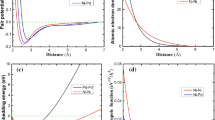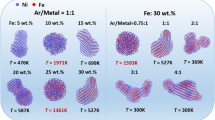Abstract
The Monte Carlo and molecular dynamics simulations were carried out for the Pt-Ni nanoparticles using the angular-dependent potential. The effects of composition, size and temperature on the structural characteristics and thermal stability of Pt-Ni nanoparticles were systematically studied. It is found that with the increase of x, the Pt concentration in each shell of PtxNi1-x nanoparticles gradually increases. The Pt atoms are dispersed, and compositional oscillations occur between the shells. The result of element segregation depends on the combined action of bond energy, strain energy, surface energy and interface energy. Pt content on the surface declines with the increase of size or temperature. With the rise of x, the melting point of PtxNi1-x nanoparticles with the same size and shape first ascends, then descends around x = 0.125, and then rises again around x = 0.5. The effect of Pt doping on the catalytic performance of Ni nanoparticles in methane dry reforming was discussed.








Similar content being viewed by others
Data availability
All data generated or analysed during this study are included in this published article and its supplementary information files.
References
M.-S. Fan, A.Z. Abdullah, S. Bhatia, Catalytic technology for carbon dioxide reforming of methane to synthesis gas. ChemCatChem 1, 192–208 (2009). https://doi.org/10.1002/cctc.200900025
A. Abdulrasheed, A.A. Jalil, Y. Gambo, M. Ibrahim, H.U. Hambali, M.Y. Shahul Hamid, A review on catalyst development for dry reforming of methane to syngas: recent advances. Renew. Sust. Energ. Rev. 108, 175–193 (2019). https://doi.org/10.1016/j.rser.2019.03.054
Z. Bian, S. Das, M.H. Wai, P. Hongmanorom, S. Kawi, A review on bimetallic nickel-based catalysts for CO2 reforming of methane. ChemPhysChem 18, 3117–3134 (2017). https://doi.org/10.1002/cphc.201700529
P. Ferreira-Aparicio, A. Guerrero-Ruiz, I. Rodrı́guez-Ramos, Comparative study at low and medium reaction temperatures of syngas production by methane reforming with carbon dioxide over silica and alumina supported catalysts. Appl. Catal. A-Gen. 170, 177–187 (1998). https://doi.org/10.1016/S0926-860X(98)00048-9
S. Barama, C. Dupeyrat-Batiot, M. Capron, E. Bordes-Richard, O. Bakhti-Mohammedi, Catalytic properties of Rh, Ni, Pd and Ce supported on Al-pillared montmorillonites in dry reforming of methane. Catal. Today 141, 385–392 (2009). https://doi.org/10.1016/j.cattod.2008.06.025
Z. Wang, X.M. Cao, J. Zhu, P. Hu, Activity and coke formation of nickel and nickel carbide in dry reforming: a deactivation scheme from density functional theory. J. Catal. 311, 469–480 (2014). https://doi.org/10.1016/j.jcat.2013.12.015
D. Pakhare, J. Spivey, A review of dry (CO2) reforming of methane over noble metal catalysts. Chem. Soc. Rev. 43, 7813–7837 (2014). https://doi.org/10.1039/c3cs60395d
H. Cheng, S. Feng, W. Tao, X. Lu, W. Yao, G. Li, Z. Zhou, Effects of noble metal-doping on Ni/La2O3–ZrO2 catalysts for dry reforming of coke oven gas. Int. J. Hydrogen Energ. 39, 12604–12612 (2014). https://doi.org/10.1016/j.ijhydene.2014.06.120
S. De, J. Zhang, R. Luque, N. Yan, Ni-based bimetallic heterogeneous catalysts for energy and environmental applications. Energ. Environ. Sci. 9, 3314–3347 (2016). https://doi.org/10.1039/C6EE02002J
O. Karaagac, B. Bilir, H. Kockar, Superparamagnetic cobalt ferrite nanoparticles: effect of temperature and base concentration. J. Supercond. Novel Magn. 28, 1021–1027 (2015). https://doi.org/10.1007/s10948-014-2798-3
C. Hasirci, O. Karaagac, H. Köçkar, Superparamagnetic zinc ferrite: a correlation between high magnetizations and nanoparticle sizes as a function of reaction time via hydrothermal process. J. Magn. Magn. Mater. 474, 282–286 (2019)
O. Karaagac, H. Köçkar, The effects of temperature and reaction time on the formation of manganese ferrite nanoparticles synthesized by hydrothermal method. J. Mater. Sci. Mater. Electron. 31, 2567–2574 (2020). https://doi.org/10.1007/s10854-019-02795-8
J.E. Manikanta, B. NagaRaju, B.S.S. Phanisankar, M. Rajesh, T.K. Kotteda, in Recent advances in mechanical engineering. ed. by G. Manik, S. Kalia, O.P. Verma, T.K. Sharma (Springer Nature Singapore, Singapore, 2023), pp.147–156
K. Omri, I. Najeh, L. El Mir, Influence of annealing temperature on the microstructure and dielectric properties of ZnO nanoparticles. Ceram. Int. 42, 8940–8948 (2016)
K. Omri, N. Alonizan, Effects of ZnO/Mn concentration on the micro-structure and optical properties of ZnO/Mn–TiO2 Nano-composite for applications in photo-catalysis. J. Inorg. Organomet. Polym Mater. 29, 203–212 (2019). https://doi.org/10.1007/s10904-018-0979-4
K. Omri, F. Alharbi, Microstructure and luminescence thermometry of transparent Mn–SZO glass ceramics with highly efficient Mn2+. J. Mater. Sci. Mater. Electron. 32, 12466–12474 (2021). https://doi.org/10.1007/s10854-021-05880-z
K. Omri, N. Alonizan, Enhanced photocatalytic performance and impact of annealing temperature on TiO2/Gd2O3: Fe composite. J. Mater. Sci. Mater. Electron. 33, 15448–15459 (2022). https://doi.org/10.1007/s10854-022-08451-y
N.A.K. Aramouni, J. Zeaiter, W. Kwapinski, M.N. Ahmad, Thermodynamic analysis of methane dry reforming: effect of the catalyst particle size on carbon formation. Energ. Convers. Manage. 150, 614–622 (2017). https://doi.org/10.1016/j.enconman.2017.08.056
J.W. Han, J.S. Park, M.S. Choi, H. Lee, Uncoupling the size and support effects of Ni catalysts for dry reforming of methane. Appl. Catal. B-Environ. 203, 625–632 (2017). https://doi.org/10.1016/j.apcatb.2016.10.069
M. García-Diéguez, I.S. Pieta, M.C. Herrera, M.A. Larrubia, L.J. Alemany, Improved Pt-Ni nanocatalysts for dry reforming of methane. Appl. Catal. A-Gen. 377, 191–199 (2010). https://doi.org/10.1016/j.apcata.2010.01.038
P. Jagódka, K. Matus, M. Sobota, A. Łamacz, Dry reforming of methane over carbon fibre-supported CeZrO2, Ni-CeZrO2, Pt-CeZrO2 and Pt-Ni-CeZrO2 catalysts. Catalysts 11, 563 (2021). https://doi.org/10.3390/catal11050563
J. Niu, Y. Wang, S.E. Liland, S.K. Regli, J. Yang, K.R. Rout, J. Luo, M. Rønning, J. Ran, D. Chen, Unraveling enhanced activity, selectivity, and coke resistance of Pt–Ni bimetallic clusters in dry reforming. ACS Catal. 11, 2398–2411 (2021). https://doi.org/10.1021/acscatal.0c04429
J. Niu, J. Ran, D. Chen, Understanding the mechanism of CO2 reforming of methane to syngas on Ni@Pt surface compared with Ni(1 1 1) and Pt(1 1 1). Appl. Surf. Sci. 513, 145840 (2020). https://doi.org/10.1016/j.apsusc.2020.145840
Z. Shang, S. Li, L. Li, G. Liu, X. Liang, Highly active and stable alumina supported nickel nanoparticle catalysts for dry reforming of methane. Appl. Catal. B-Environ. 201, 302–309 (2017). https://doi.org/10.1016/j.apcatb.2016.08.019
N. Metropolis, A.W. Rosenbluth, M.N. Rosenbluth, A.H. Teller, E. Teller, Equation of state calculations by fast computing machines. J. Chem. Phys. 21, 1087–1092 (1953). https://doi.org/10.1063/1.1699114
G. Wang, Y.-S. Xu, P. Qian, Y.-J. Su, The effects of size and shape on the structural and thermal stability of platinum nanoparticles. Comput. Mater. Sci. 169, 109090 (2019). https://doi.org/10.1016/j.commatsci.2019.109090
G. Wang, Y. Xu, P. Qian, Y. Su, Vacancy concentration of films and nanoparticles. Comput. Mater. Sci. 173, 109416 (2020). https://doi.org/10.1016/j.commatsci.2019.109416
Y. Xu, G. Wang, P. Qian, Y. Su, Element segregation and thermal stability of Ni–Rh nanoparticles. J. Solid State Chem. 311, 123096 (2022). https://doi.org/10.1016/j.jssc.2022.123096
J.-S. Kim, D. Seol, J. Ji, H.-S. Jang, Y. Kim, B.-J. Lee, Second nearest-neighbor modified embedded-atom method interatomic potentials for the Pt-M (M = Al Co, Cu, Mo, Ni, Ti, V) binary systems. Calphad 59, 131–141 (2017). https://doi.org/10.1016/j.calphad.2017.09.005
R.R. Hultgren, Selected values of the thermodynamic properties of binary alloys, American Society for Metals, New York, 1973
G. Kresse, J. Hafner, Ab initio molecular dynamics for liquid metals. Phys. Rev. B 47, 558–561 (1993). https://doi.org/10.1103/PhysRevB.47.558
G. Kresse, J. Furthmüller, Efficient iterative schemes for ab initio total-energy calculations using a plane-wave basis set. Phys. Rev. B 54, 11169–11186 (1996). https://doi.org/10.1103/physrevb.54.11169
J.P. Perdew, J.A. Chevary, S.H. Vosko, K.A. Jackson, M.R. Pederson, D.J. Singh, C. Fiolhais, Atoms, molecules, solids, and surfaces: applications of the generalized gradient approximation for exchange and correlation. Phys. Rev. B 46, 6671–6687 (1992). https://doi.org/10.1103/PhysRevB.46.6671
S. Plimpton, Fast parallel algorithms for short-range molecular dynamics. J. Comput. Phys. 117, 1–19 (1995). https://doi.org/10.1006/jcph.1995.1039
J. Tang, L. Deng, S. Xiao, H. Deng, X. Zhang, W. Hu, Chemical ordering and surface segregation in Cu–Pt nanoalloys: the synergetic roles in the formation of multishell structures. J. Phys. Chem. C 119, 21515–21527 (2015). https://doi.org/10.1021/acs.jpcc.5b06145
L. Deng, X. Liu, X. Zhang, L. Wang, W. Li, M. Song, J. Tang, H. Deng, S. Xiao, W. Hu, Intrinsic strain-induced segregation in multiply twinned Cu–Pt icosahedra. Phys. Chem. Chem. Phys. 21, 4802–4809 (2019). https://doi.org/10.1039/C8CP06327C
G. Wang, Y. Xu, P. Qian, Y. Su, ADP potential for the Au-Rh system and its application in element segregation of nanoparticles. Comput. Mater. Sci. 186, 110002 (2021). https://doi.org/10.1016/j.commatsci.2020.110002
Y. Xu, G. Wang, P. Qian, Y. Su, Element segregation and thermal stability of Ni–Pd nanoparticles. J. Mater. Sci. 57, 7384–7399 (2022). https://doi.org/10.1007/s10853-022-07118-7
A. Zaleska-Medynska, M. Marchelek, M. Diak, E. Grabowska, Noble metal-based bimetallic nanoparticles: the effect of the structure on the optical, catalytic and photocatalytic properties. Adv. Colloid Interface Sci. 229, 80–107 (2016). https://doi.org/10.1016/j.cis.2015.12.008
M. Cui, H. Lu, H. Jiang, Z. Cao, X. Meng, Phase diagram of continuous binary nanoalloys: size, shape, and segregation effects. Sci. Rep. 7, 41990 (2017). https://doi.org/10.1038/srep41990
W.R. Tyson, W.A. Miller, Surface free energies of solid metals: estimation from liquid surface tension measurements. Surf. Sci. 62, 267–276 (1977). https://doi.org/10.1016/0039-6028(77)90442-3
C. Kittel, Introduction to solid state physics, 8th edn. (John Wiley & Sons, New York, 2005)
P. Gao, Q. Wu, X. Li, H. Ma, H. Zhang, A.A. Volinsky, L. Qiao, Y. Su, Size-dependent concentrations of thermal vacancies in solid films. Phys. Chem. Chem. Phys. 18, 22661–22667 (2016). https://doi.org/10.1039/C6CP03419E
L. Deng, H. Deng, S. Xiao, J. Tang, W. Hu, Morphology, dimension, and composition dependence of thermodynamically preferred atomic arrangements in Ag–Pt nanoalloys. Faraday Discuss. 162, 293–306 (2013). https://doi.org/10.1039/C3FD20138D
J. Tang, L. Deng, H. Deng, S. Xiao, X. Zhang, W. Hu, Surface segregation and chemical ordering patterns of Ag–Pd nanoalloys: energetic factors, nanoscale effects, and catalytic implication. J. Phys. Chem. C 118, 27850–27860 (2014). https://doi.org/10.1021/jp507710k
Q. Mei, K. Lu, Melting and superheating of crystalline solids: from bulk to nanocrystals. Prog. Mater. Sci. 52, 1175–1262 (2007). https://doi.org/10.1016/j.pmatsci.2007.01.001
Z.L. Wang, J.M. Petroski, T.C. Green, M.A. El-Sayed, Shape transformation and surface melting of cubic and tetrahedral platinum nanocrystals. J. Phys. Chem. B 102, 6145–6151 (1998). https://doi.org/10.1021/jp981594j
F. Baletto, R. Ferrando, Structural properties of nanoclusters: energetic, thermodynamic, and kinetic effects. Rev. Mod. Phys. 77, 371–423 (2005). https://doi.org/10.1103/revmodphys.77.371
A.T. Dinsdale, SGTE data for pure elements. Calphad 15, 317–425 (1991). https://doi.org/10.1007/10655491_1
F. Predel, Phase equilibria, crystallographic and thermodynamic data of binary alloys, 1st edn. (Springer, Berlin Heidelberg, 2016)
Acknowledgements
This study was supported by the Dean’s fund of TianJin College, University of Science and Technology Beijing (Grant No. 2020YZJJ-KJ01) and the National Key Research and Development Program of China (Grant No. 2021YFB3802100).
Funding
Dean’s fund of TianJin College, University of Science and Technology Beijing, 2020YZJJ-KJ01, Gang Wang, National Key Research and Development Program of China, 2021YFB3802100, Ping Qian.
Author information
Authors and Affiliations
Corresponding authors
Ethics declarations
Conflict of interest
The authors declare that they have no conflict of interest.
Additional information
Publisher's Note
Springer Nature remains neutral with regard to jurisdictional claims in published maps and institutional affiliations.
Supplementary Information
Below is the link to the electronic supplementary material.
Rights and permissions
Springer Nature or its licensor (e.g. a society or other partner) holds exclusive rights to this article under a publishing agreement with the author(s) or other rightsholder(s); author self-archiving of the accepted manuscript version of this article is solely governed by the terms of such publishing agreement and applicable law.
About this article
Cite this article
Wang, G., Xu, Y. & Qian, P. Structural characteristics and thermal stability of Pt-Ni nanoparticles. Appl. Phys. A 129, 105 (2023). https://doi.org/10.1007/s00339-022-06381-4
Received:
Accepted:
Published:
DOI: https://doi.org/10.1007/s00339-022-06381-4




